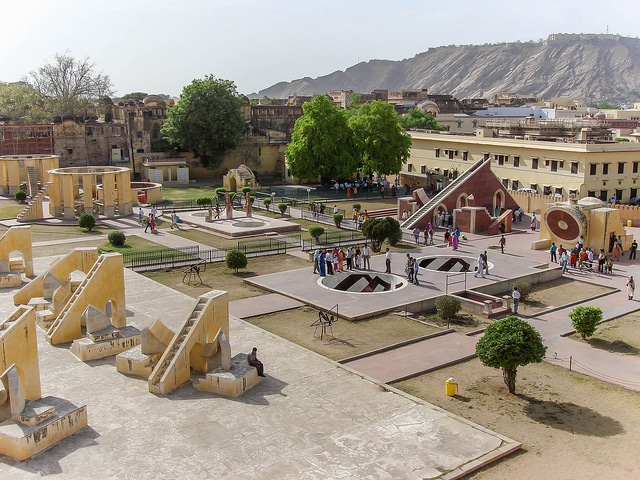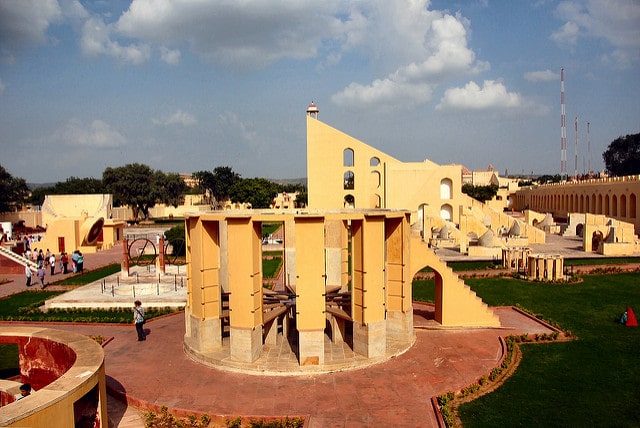A set of 14 massive astronomical instruments that now stand as a structure of brilliance in architecture, the Jantar Mantar Observatory in Jaipur is an attraction of its own kind. Built by Maharaja Jai Singh II in order to help him predict his fate in upcoming wars, Jantar Mantar is presently known for its clever use of geometrical patterns in the form of instruments. Situated in the heart of the city of Jaipur, Jantar Mantar has attracted tourists from all over India and outside, and for good reason. Here is a list of things that will tell you why Jantar Mantar is such a wonder to observe.
Interesting Facts
- Jantar Mantar is one of the five astronomical complexes constructed by Maharaja Jai Singh II, and the one in Jaipur is the largest and most well preserved.
- The advanced instruments in Jantar Mantar were useful in predicting eclipses, location of stars and the exact orbiting movements of the earth around the sun.
- The Samrat Yantra aka the Giant Sundial, is the centrepiece of the complex, known as the world’s tallest sundial with a height of 27 metres and a 6cm per minute speed of shadow movement.
- The name ‘Jantar Mantar’ is derived from the Hindi words yantra meaning instrument and mandir meaning temple. During the British rule in India, the names were mistranslated which morphed into Jantar Mantar and have gained popularity that way since.
- The instruments were so designed for Pandit Jagannath, the advisor and guru of Maharaja Jai Singh II, to help him create birth charts and predictions of major events like deaths, wars, weddings etc.
- Similar observatories called Jantar Mantar were created by Maharaja Jai Singh II in four other places like Delhi, Ujjain, Varanasi and Mathura, with the largest being in Jaipur.
- The instruments were built through inspiration taken from the Islamic school of astronomy, which was known to be the most advanced method of that time.
- Jantar Mantar as an observatory was built as an example of the Ptolemaic positional astronomy, which was common with many other civilizations.
- The three major celestial coordinate systems are represented in the instruments, them being: the horizon-zenith local system, the equatorial system and the ecliptic system.
Things to See
The instruments in Jantar Mantar include the following-
- Chakra Yantra, the instrument that gives the position of the sun at four different times during the day.
- Dakshin Bhitti Yantra measures the altitude, meridian and zenith distances of the celestial bodies.
- Digamsha Yantra is used to calculate the timings of sunrise and sunset forecasts.
- Dhruva Darshak Pattika observes the location of the pole star as per the position of other celestial bodies.
- Jai Prakash Yantra is an instrument that maps the inverted side of the sky, and lets one walk through the instrument to observe the changes.
- Kapali Yantra is used to measure the position of celestial bodies and equatorial systems.
- Kranti Vritta Yantra measures the longitude and latitude of celestial entities.
- Laghu Samrat Yantra is a smaller version of the largest sundial instrument.
- Rama Yantra is a double cylinder instrument with capability of measuring the celestial bodies and their positions and altitudes.
- Shastansh Yantra is a 60-degree arc in a chamber helps measure the distance and diameter of the sun.
- Unnatasha Yantrais a metal ring which divides itself into four segments to be able to measure altitude and distance of celestial bodies.
Traveller Tips
- Wear comfortable footwear to be able to walk around the large complex and observe the instruments properly.
- Photography is permitted but there are charges for the same.
- It takes 30 minutes to an hour for exploring Jantar Mantar, which gives a visitor enough time to look at other tourist destinations as well in the same day.
Timings
9am to 4.30pm Monday to Friday
Entry Fee
Indians (adult/child)- Rs.40
Foreign visitors (adult/child)- Rs.200
Availability of Guides
Local guides- Rs.200
Audio guide- Rs.150
Camera fees- Rs.50
Nearby Attractions
- City Palace of Jaipur is located right across from Jantar Mantar, along with Hawa Mahal, Albert Hall Museum, Ram Niwas Bagh, and Amber Fort etc. that can be found close by.
- Swargasuli tower, Tripolia Bazaar, Chandpol Bazaar, New Maharaja Gem Palace etc. are popular tourist spots around the area of Jantar Mantar in the main city region.
- Maharaja Sawai Man Singh II Museum, Johri Bazaar, Moti Dungari temple, Heritage textiles, and Nahargarh Fort are located nearby.
With Jaipur’s vast history, an insight into the calculative and sharp minds of the royal families can be obtained through the construction and architecture. Jantar Mantar is one such example of the excellence of the rulers of Jaipur and neighbouring regions of Mewar, who paid a lot of attention to detail when it came to architecture in their kingdoms.



